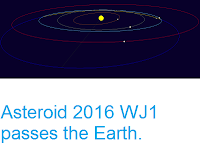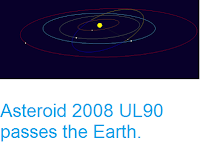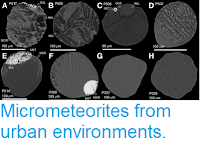Asteroid 2006 XD2 passed by the Earth at a distance of about 7 248 000
km (18.9 times the average distance between the Earth and the Moon, or 4.85% of the distance between the Earth and the Sun), at about 7.55 am GMT on Wednesday 21 December 2016. There was no danger of
the asteroid hitting us, though were it to do so it would have
presented a considerable threat. 2006 XD2 has an estimated equivalent
diameter of 120-380 m (i.e. it is estimated that a spherical object with
the same volume would be 120-380 m in diameter), and an object of this
size would be predicted to be capable of passing through the Earth's
atmosphere relatively intact, impacting the ground directly with an
explosion that would be 3500-165 000 times as powerful as the Hiroshima
bomb. Such an impact would result in an impact crater 1-6 km in diameter
and devastation on a global scale, as well as climatic effects that
would last decades.
Image of 2006 XD2 captured on 20 December 2006. The asteroid is the
dot at the centre of the picture, the elongate objects are stars; this
is caused by the camera tracking the asteroid on a long exposure. Nick James/The Astronomer.
2006 XD2 was discovered on 12 December 2006 by the Massachusetts Institute of Technology's Lincoln Near Earth Asteroid Research Laboratory in Socorro, New Mexico. The designation 2006 XD2 implies that it was the 54th asteroid
(asteroid D2) discovered in the first half of December 2006 (period
2006 X).
2006 XD2 has a 521 day orbital period and an eccentric orbit tilted at an angle of 3.56° to the plane of the Solar System, which takes it from 0.73 AU from the Sun (i.e. 73% of he average distance at which the Earth orbits the Sun, roughly the distance at which the planet Venus orbits the Sun) to 1.80 AU from the Sun (i.e. 180% of the average distance at which the Earth orbits the Sun, and considerably outside the orbit of the planet Mars). It is therefore classed as an Apollo Group Asteroid (an asteroid that is on average further from the Sun than the Earth, but which does get closer). This means that close encounters between the asteroid and Earth are extremely common, with the last having occurred in June 2014 this year and the next predicted in May 2024. As an asteroid probably larger than 150 m in diameter that occasionally comes within 0.05 AU of the Earth, 2006 XD2 is also classified as a Potentially Hazardous Asteroid.
The calculated orbit of 2006 XD2. Minor Planet Center.
2006 XD2 also
has frequent close encounters with the planets Venus, which it is
thought to have last passed in March 2004, and is next predicted to
pass in June 2031, and Mars which it last came close to in December 1995 and
is next predicted to pass in May 2084). Asteroids
which make close passes to multiple planets are considered to be in
unstable orbits, and are often eventually knocked out of these orbits by
these encounters, either being knocked onto a new, more stable orbit,
dropped into the Sun, knocked out of the Solar System or occasionally
colliding with a planet.
See also...
Follow Sciency Thoughts on Facebook.








